Month: November 2017
Sustainapalooza

Music festivals are a time to embrace new perspectives, connect with diverse groups of people, and enjoy great music but should this fun come at the cost of the earth? After attending Summer Set Music Festival this summer, I was astounded by the amount of waste left over. By the fourth day of the festival, a once pristine, beautiful campground was riddled with piles of crushed water bottles, left behind tents, and cigarette butts.
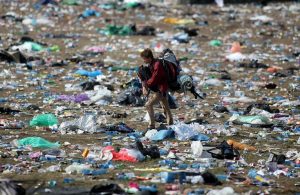
Although many festival goers are lovers of the environment, many become caught up in the hype oblivious to the waste they are creating. Music festivals produce on average 6 pounds of waste per person (Creative Carbon Scotland Music). That’s almost twice the national average! For a music festival such as Bonnaroo or Lallapalooza with over 60,000 people over 720 tons of waste is produced not including the fuel for stages and shuttles or the waste produced by vendors themselves. Typically once people enter the campsite there is no leaving, so the music venues must take action in advance to provide sustainable options and inform people of how they can prepare.
Here are a few options music festival venues could employ to reduce the amount of waste:
1. Provide campers with a green guide after buying tickets to help them pack sustainably with reusable bags or water bottles
2. Have water stations available so that campers may refill their water bottles or packs
3. Give each car entering the campsite a recycling bag which they can drop off after the festival to be properly disposed of
4. Offer free t-shirts, rides, or reusable water bottle for bringing in empty plastic water bottles or used cigarette butts. Currently Coachella offers a free reusable water bottle for every ten empty plastic water bottles campers recycle.
5. Have a bike parking lot to encourage festival goers to not use the shuttles
6. Make sure charity boxes are available at the end of the festival for unwanted items like tents.
7. Require food vendors to use recyclable plates, utensils, and cups
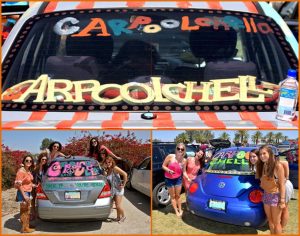
As a camper you can even reduce waste before you enter the festival by carpooling to the grounds with three or more people in order to reduce fuel usage. Carpoolchella is an app where Cochella festival goers who ride with four or more in a car can be entered into a raffle to win prizes!
Have a fun, hippie, and sustainable music festival!
-Kelsey DiMarco
References:
https://www.google.com/amp/s/amp.mindbodygreen.com/articles/can-a-music-festival-be-100-percent-sustainable-7-creative-ways-festivals-are-getting-close
http://www.conservationvalue.org
A Spin on Everyday Transportation
If you have been living in a shell the last month or have trouble seeing then you probably didn’t notice the bright orange bikes EVERYWHERE around campus. Spin bikes are spreading across the country, and influencing others to adopt a more sustainable alternative to driving.
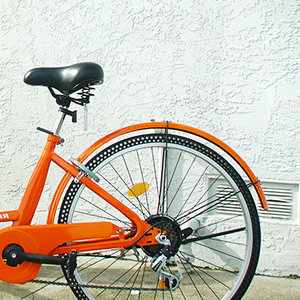
“In its first 20 days, SPIN saw 656 unique riders and 4,500 rides more rides at Furman in the first week than did Seattle, Spin’s inaugural launch site” (1).What is all the hype around spin bikes? I mean bikes have been around for hundreds of years; the earliest bicycle being a wooden scooter-like contraption called a celerifere, invented around 1790 by a guy named Comte Mede de Sivrac. What’s so cool about spin bikes is that they are one of the first dockless bike sharing programs to launch across the U.S. with their Spin Cities Project launching first in Seattle.
A lot of my friends (and maybe sometimes me too) drive to class when we are running late in the morning or just around campus on a busy day. It only takes at most about 15 minutes to walk to any place on campus; although some of us like to convince ourselves that we don’t have 15 minutes in our busy day to spare. Then why not use our own bikes that a good percentage of our students have here on campus? It’s all about convenience, sometimes I don’t want to have to worry about riding my bike everywhere around campus during a school day and having to worry about locking it up every time and weaving in and out between the busy students waking between the academic buildings; sometimes Isimply prefer talking and walking besides classmates as well. Spin has no obligations, you can leave it anywhere and you can lock it with a click of a button
I use Spin bike almost 4 days aweek and it has become such a great way to get around campus. I have stopped driving my car around campus and I am rarely late to class anymore. My boyfriend and I can finally go on bikes rides together and take quick trips down trough the Swamp Rabbit Trail to have lunch in Travelers Rest. Majority of students don’t use their cars further than 5-10 miles from campus so Spin bikes are great for eliminating unnecessary car usage within short d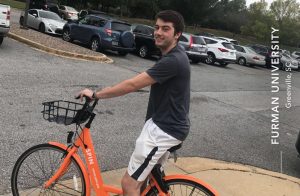 istances, limiting the pollution in cities and campuses. Let me just say, I am a fan of Spin bikes and would recommend them to other students and other campuses to give them a try for their superb ease of use.
istances, limiting the pollution in cities and campuses. Let me just say, I am a fan of Spin bikes and would recommend them to other students and other campuses to give them a try for their superb ease of use.
– Natalia Baldwin
References
- https://news.furman.edu/2017/11/02/furman-taking-dockless-bike-share-program-for-a-spin/
- https://seattle.curbed.com/2017/7/17/15980792/spin-orange-bike-share-launch
- https://www.spincities.org
The Not So Small Issue of Food Waste
Here at a small, liberal arts university you wouldn’t think that food waste would be much of a problem. However, in an era of convenience and material goods, most people on campus take the accessibility of food for granted. We don’t need to worry about where our food is coming from, whether it will be available, how many resources went into cooking it, or where our scraps go after we finish our meal. The concept of the clean plate club flew out the window as soon as we left Mom’s domain.
As part of Furman’s sustainability initiative, we compost all the food waste created by the dining hall and from several other places on campus. On average we process more than 32 tons of food waste per year, most of which is composted. However, we only seem to use a minuscule portion of the compost, most significantly on Furman’s organic farm.
In our little Furman bubble we do not often think about our own wastefulness and its impact on our community and the rest of the world. There are people in our community who may not know where their next meal is coming from, while we continue to throw away huge proportions of food. We also expend resources (i.e. time, effort, energy as natural gas and electricity) in composting the food, the value of which exceeds the compost’s usefulness on our campus. In light of this, I find our wastefulness both unsustainable and disheartening to those less fortunate. However, I think that composting the food waste on campus is a wonderful idea, as it keeps most of the waste from entering landfills and generating leachate, and stopping this entirely would be a step in the wrong direction. But, the sheer volume of our output is far too great for our small size. There must be a change in this system moving forward.
Ideally, we would decrease our food waste and replace the chemical fertilizers that we currently use in landscaping with the mature compost. The dining hall could make changes as giving smaller portions, offering samples of the foods, or allowing students to serve themselves at some lines. Making the campus’ compost available as a marketable item for local farmers is also a good option. These changes could greatly benefit the campus, not just in the food waste, but with removing some of the harmful chemicals from our landscaping process. However, none of these suggestions are ‘one size fits all’ and though they could be successful in other situations, it does not mean they will be on this campus. For this reason, I think the school should encourage ongoing conversation to help evaluate and correct this system as it develops. I hope that through ventures like this, we can grow to more mindful of our actions and become better stewards of our planet.
Mikaela Williams
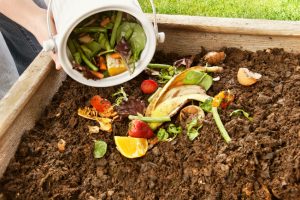
Nike’s Shift Towards Sustainability
The company Nike, a major sports clothing and shoes distributor around the world, has made huge steps towards a more eco-friendly and sustainable style of production and manufacturing. The company released three goals as part of their sustainability project, which are to “minimize environmental footprint, transform manufacturing, and unleash human potential.” Nike has strived towards these goals by making changes in their factories and materials as well as by reaching out to young children to stress the importance of physical activity.
Several ways that Nike has altered its production style are shown through the use of different shoe technology, water-conserving techniques, and energy cuts. Nike has introduced a new shoe material called Flyknit technology, which provides the maximum structural support for athletes while remaining lightweight and easy to wear during physical activity. While providing the shoes needed for athletes to perform to their best ability, Flyknit technology also produces 60 percent less waste than traditional methods of making shoes. Along with a different shoe technology, the company has also introduced new methods of saving water during production in factories. Nike has started using a new dying method called ColorDry, which dyes fabric without using water. To make better use of recyclable and reusable trashed materials, Nike has found a way to utilize plastic bottles and material from old original Nike material to produce new clothes and shoes. Between 2008 and 2016, the company has rerouted more than 3 billion plastic bottles headed for the landfill and has instead turned these bottles into recycled polyester for Nike products. Also, the new plan Nike Grind has been introduced to use materials from older clothing as the framework for new clothing, saving fabric. In order to conserve energy, the Nike footwear manufacturers have cut down on energy needed and emissions generated to make shoes by 50 percent, saving company money while also helping the environment.
Along with making changes in the factory setting, Nike has also strived to push children to live more active lifestyles, which is another essential part of sustainability because it has been proven that physically active people are happier, healthier, and more vibrant. In order to influence this healthier way of life, Nike has reached out to schools around the world to spread awareness of the physical inactivity epidemic and to influence children to get up and moving as often as possible. By working with movements such as Let’s Move! Active Schools, Nike has impacted the lives of children across the globe by influencing healthy physical activity.
Clearly, Nike has made some serious changes to company habits and partnerships to make it a more sustainable business. These changes impact lives everywhere because Nike is a major sportswear company with lots of influence on the economy of the world and the depletionor conservation of natural resources.
Source: http://news.nike.com/news/sustainable-innovation
~Danni Vines
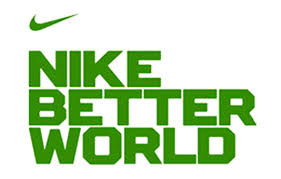
The Mysterious Incident of the Compost in the Nighttime
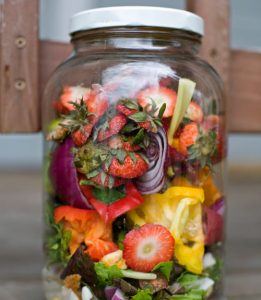 Compost.
Compost.
Did you just picture a stinky pile of rotting fruits and veggies? Then you’re in the same boat as the majority of Americans. Composting sounds scary, but if it’s done right, it’s actually a simple, sustainable, and stink-free way to save money, create less waste, and make your own organically fertilized soil!
At the beginning of the school year, I was eager to try my hand at composting, but I didn’t how to do. After some coaching from Bruce the farm manager though, the Cabin was ready to try composting in the Tumbleweed behind our new home.
The basic principle behind composting is simple: let nature do its work. Soil contains natural microorganisms that break down organic matter, so in order to have a healthy compost pile, you want to make an environment to speed up this process of natural decomposition (as opposed to molding and rotting). For us, this meant getting a mix of partially-decomposed leaves, soil that already contained some compost from the Farm, a few banana peels, and coffee grounds. That was it! And the compost pile was ready to go.
We keep an over-sized mason jar in the fridge to put compostable materials in and then empty it into the tumbleweed about once a week. We compost egg shells, fruit and veggie scraps, tea bags, coffee grounds, and paper napkins but make sure to exclude non-compostable material like meet scraps, dairy products, and very oily or molded foods. Everything seemed to be going according to plan…
Until we started seeing green bags of trash periodically appear in our tumbleweed. Someone in the community must have thought it was a trashcan. To solve the problem, we labeled the compost bin “Not a trashcan!” and when that didn’t work, we tried a different approach: “If you would like to compost with us please contact us at this email address.” We eagerly awaited an email from the mystery want-to-be-composter, but heard nothing. About every week another bag of trash would appear and I would take it out and throw it away. We were stumped.
Finally, we caught the culprit! …who wasn’t actually a culprit… and wasn’t actually putting trash in the compost bin. It turns out, that one of my own cabin mates was using green, compostable plastic bags to bring waste from the environmental science department to add to our compost bin. The mystery was solved! We could once again rest in peace.
Ansley Glenn ’20
source: http://www.bhg.com/gardening/yard/compost/how-to-compost/
Image from: https://i.pinimg.com/originals/91/d6/55/91d655912d3682c48479f0a4ad306c6c.jpg